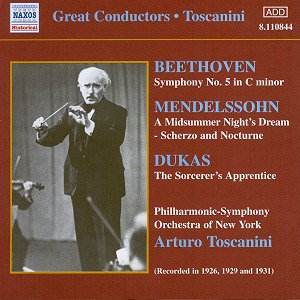As promised by Naxos this fifth and final volume in
their complete Toscanini/New York Philharmonic Symphony brings us the
1931 Beethoven fifth. The producer and restoration engineer Mark Obert-Thorn
notes that there were technical problems in the recording, citing sonic
compressed dubbing and obtrusive noise (there are some resoundingly
loud coughs itís true) though I was always under the impression that
this live performance from Carnegie Hall was recorded on optical film
and copies dubbed from it. Nevertheless as I noted in my
review of the 1933 Fifth in this series Ė Naxos 8.110840 - this
earlier traversal is marginally the superior performance. To the latterís
power and directness can be added the earlier performances lyrical persuasiveness
and also its pliant and sensitive phrasing.
The two other performances on this disc receive 'Completists-only'
saturation coverage. At this price itís no bad thing to have two takes
Ė virtually identical - of The Sorcererís Apprentice though surely
even Toscaninians may squint at the thought of three versions of the
scherzo from A Midsummer Nightís Dream, especially as the conductor
is in unconvincing form in the earliest of them. This dates from 1926
and was recorded for Brunswick - a little lumpy and lethargic. By 1929
Toscanini was recording rather more confidently Ė though still unwillingly
- for Victor and the two takes of the scherzo from that session (all
three feature flautist John Amans) are again almost identical. Both
here and in the Dukas we can feel the almost frightening brilliance
of Toscaniniís waspish speeds and fluent articulation Ė I really donít
much care for the show-off Dukas performances but others will admire
the undoubted orchestral virtuosity and itís certainly right that Naxos
include all the takes Ė all these takes were issued by the way Ė in
this comprehensive and excellently transferred series.
Jonathan Woolf


